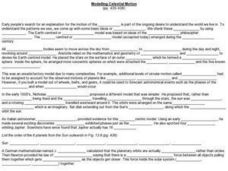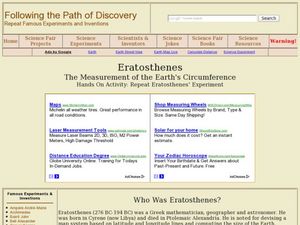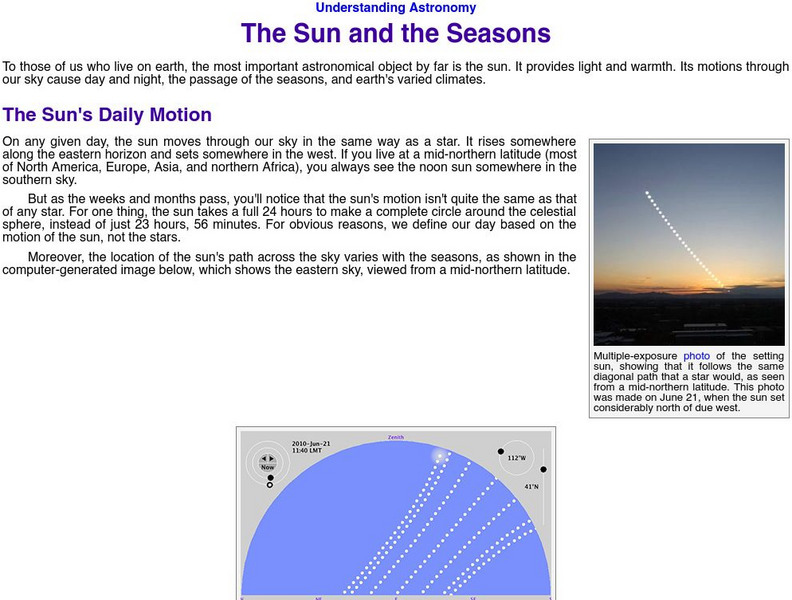Curated OER
The Celestial Sphere and Circumpolar Motion
Students investigate the celestial sphere and circumpolar motion. For this science lesson, students view an applet, The Celestial Sphere and Circumpolar Motion. Students discuss the Earth's rotation and stellar movement.
National Center for Case Study Teaching in Science
Mask of the Black God
Finally, an astronomy lesson for the high schooler! Explorers are able to read star maps for finding objects in the night sky by determining celestial coordinates. In particular, they locate the Pleiades and read about a Navajo legend...
Curated OER
Azimuth and Altitude Quiz 1
In this azimuth and altitude learning exercise, students answer questions about celestial bodies and how they are measured. They label drawings of clinometers, celestial spheres, and a compass.
Curated OER
The Celestial Sphere
Learners are introduced to the celestial sphere, describing its apparent rotation and the special role of the pole star.
Curated OER
Tracking the Sun with a Solar Dome
Pupils study the sun and how it moves throughout the day. In this tracking the sun instructional activity students create a model of the celestial sphere.
Curated OER
Modeling Celestial Motion
In this modeling celestial motion worksheet, students fill in the blank about the motion of celestial bodies: planets and stars. Students complete the blanks with information about the scientists and philosophers responsible for early...
Curated OER
How Fast Does the Sun Spin?
In this rotation of celestial bodies learning exercise, students determine the speed of the sun's rotation and they determine the number of days it takes the sun to rotate once at the equator. They identify the geometric factor that...
Curated OER
The Path of the Sun: The Ecliptic
Learners investigate the celestial sphere and the paths it takes in the solar system.
Curated OER
Scavenger Hunt
Students study a research telescope to obtain quantitative information about these objects. They use the SkyServer Navigation Tool to identify objects and record celestial coordinates. In addition, they associate star brightness and...
Curated OER
Three D Constellations
Students are introduced to both celestial coordinates and to the first rung on the distance determination ladder. They convert spherical coordinates to Cartesian coordinates to construct a three dimensional model of a constellation...
Curated OER
An Introduction to the Night Sky and Movement Astronomy
Basically, this is an interactive exploration of educational astronomy software and an app. Young astronomers discover how the apparent motion of the sky relates to Earth's movements and the position of the observer. It is out of this...
Curated OER
Apparent Motion of the Sun
Demonstrate the path of the sun across the sky at different times of the year with an engaging science lesson. Learners use a series of questions and diagrams to examine the movement of the sun and appearance of the sky around...
Weber State University
The Sun and the Seasons
Why is there more daylight in June than in December if you live above the equator? How does the angle of sunlight shift throughout the year? Answer these questions and more with an interactive article about the sun, its path through the...
Curated OER
Astronomy Class
In this space science worksheet, students find the words associated with the basic terms of Astronomy. The answers are located at the bottom of the page.
Curated OER
The Path of the Sun, the Ecliptic
Students are introduced to the ecliptic, the zodiac and the apparent motions of the Sun, Moon and planets across the sky.
Curated OER
Fantasy Allegory of Air
Learners analyze the painting Jan Brueghel and design their own book. In this art and book lesson, students discuss the elements of fantasy from the painting and create their own book. Learners illustrate the book and create a painting...
Curated OER
Lesson Plans for Fantasy: Allegory of Air
Students use combinations of real and imaginary objects to create illustrations for a book. In this Fantasy in art instructional activity, students discuss the elements of fantasy in Allegory of Air. Students study the work...
Curated OER
Eratosthenes
Students examine what Eratosthenes is and the history behind him. In this earth instructional activity students complete a hands on activity to repeat Eratosthenes' experiment.
Curated OER
Retrograde Motion
Students study the motions of the heavenly bodies. In this space instructional activity students use models to show a variety of schemes explaining the motions.
Texas Instruments
Texas Instruments: Celestial Sphere Study Cards
Multiple choice study cards for reviewing the Celestial Sphere.
American Association of Physics Teachers
Com Padre Digital Library: Open Source Physics: Celestial Globe Model
Users have the opportunity to adjust several variables in this simulation demonstrating the Ancient Greek's Two Sphere Universe theory.
Curated OER
The Four Corners of the World Supporting the Celestial Sphere
An image of "The Four Corners of the World Supporting the Celestial Sphere", created by Jean-Baptiste Carpeaux in 1872 (Original plaster model, height 280 cm).
Georgia Department of Education
Ga Virtual Learning: Astronomy: The Earth
In this interactive tutorial students will learn what causes the seasons, diurnal cycles and how the constellations move through the sky. Learn we are able to see other planets and how astronomical events affected life on the Earth.
Other
Weber State University: The Sun and the Seasons
To those of us who live on earth, the most important astronomical object by far is the sun. This article explains how the motion of the sun through our sky cause day and night, the passage of the seasons, and earth's varied climates.

























